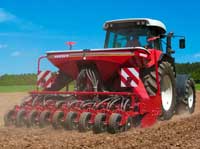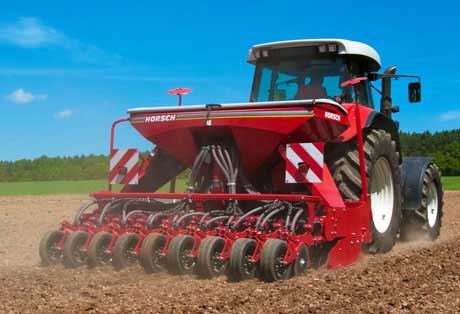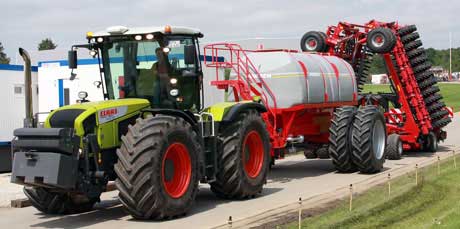New drill and return to self-propelled sprayers for Horsch

A new 3m drill, 25t chaser bins and a return to sprayer manufacture – Horsch had a lot to say at its 25th birthday bash, as Andy Collings reports
Drills
 |
|---|
| The new 3m tractor mounted Express HD pneumatic seed drill. Note the close positioning of the 1500-litre hopper at the rear of the tractor to help reduce linkage loading. |
But the launch of the Express HD 3m drill marks a return to equipment for smaller-acreage customers. This model is designed for use on ploughed land or, where soil conditions allow, as part of a min-till crop establishment system.
Primary cultivation comes from two rows of discs, followed by a height-adjustable levelling rake. Then there are 18 double-disc seed coulters working at 150kg with spring protection against large stones.
Seed is held in a 1500-litre hopper mounted close to the tractor to reduce the load on the linkage. A ground speed radar-controlled metering unit delivers seed into the fan-generated air flow and then, via the distribution head, to the individual coulters.
Each disc coulter is followed by a press wheel which also controls the depth of drilling.
 |
|---|
| This 12m Pronto 12DC drill is aimed at the North American market, where N P and K are applied separately by GPS variable rate application. Twin hoppers each contain 8500 litres – all-up weight is over 22t and power requirement 500-650hp. |
Chaser bins
Though Horsch introduced its first chaser bin in 1990, it pulled out of the market in 2002 because it reckoned its models were too small. However next year will mark the company’s return to this sector with a 25t single-auger chaser bin that will hold enough grain to fill a lorry with just one load.
Company boss Michael Horsch says that such capacity is necessary to maximise the efficiency of the transport of grain from field to store. “Large combines need to be kept on the move and any delays caused by grain transport problems can be expensive,” he says.
Sprayers
Horsch says it also plans to return to the self-propelled sprayer sector within the next three years, a market it pulled out of in 1994. A prototype is already under way.
“The global market for self-propelled sprayers is growing year on year,” says Mr Horsch. “It is currently running at 20,000 units a year – an enormous market which we aim to take a slice of.”
Localised cultivation
One of Horsch’s latest projects involves a combination of no-till, controlled traffic and so-called localised cultivation crop establishment.
“The idea is to cultivate only where the seed is to be placed and provide an environment where the soil is free draining, where the developing plant’s roots can flourish and where there is plant food available,” explains Mr Horsch. “The advantages of the system are a reduced fertiliser requirement, lower cultivation costs and stronger plants that go to yield well.”
He points out that while this is relatively easy to achieve in widely spaced crops like maize or oilseed rape, it is much more difficult with wheat or barley.
Key to the system is an ultra-accurate tractor guidance system that can be set to run down the same wheelings and ensure that drill coulters track the cultivated slots created by a cultivator in a previous pass.
“We are working with 6m wide drills and cultivators,” he says. “The 12cm wide cultivator tines work at 30cm widths and at a depth of 30cm, while the drill places the seed as a band in each of the 12cm cultivated slots.”
He adds that the ground can be cultivated after harvest and then drilled with autumn-sown crops or left until the spring – weed growth is sprayed off where necessary.

